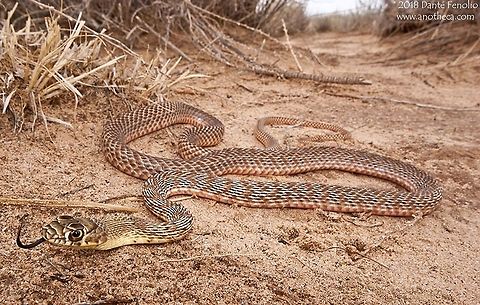
Appearance
Coachwhips are thin-bodied snakes with small heads and large eyes with round pupils. They vary greatly in color, but most reflect a proper camouflage for their natural habitat. ''M. f. testaceus'' is typically a shade of light brown with darker brown flecking, but in the western area of Texas, where the soil color is a shade of pink, the coachwhips are also pink in color. ''M. f. piceus'' was given its common name because specimens frequently, but not always, have some red in their coloration. Coachwhip scales are patterned so at first glance, the snake appears braided. Subspecies can be difficult to distinguish in areas where their ranges overlap. Adult sizes of 127–183 cm are common. The record sized specimen, of the Eastern coachwhip race, was 259 cm . Young specimens, mostly just over 100 cm in length, were found to have weighed 180 to 675 g , whereas good-sized mature adults measuring 163 to 235 cm weighed in at 1.2 to 1.8 kg .Naming
*Sonoran coachwhip, ''Masticophis flagellum cingulum'' Lowe & Woodin, 1954⤷ Eastern coachwhip, ''Masticophis flagellum flagellum''
⤷ Baja California coachwhip, ''Masticophis flagellum fuliginosus''
⤷ Lined coachwhip, ''Masticophis flagellum lineatulus'' H.M. Smith, 1941
⤷ Red coachwhip , ''Masticophis flagellum piceus''
⤷ San Joaquin coachwhip, ''Masticophis flagellum ruddocki'' Brattstrom & Warren, 1953
⤷ Western coachwhip, ''Masticophis flagellum testaceus''
Behavior
Coachwhips are diurnal, and actively hunt and eat lizards, small birds, and rodents. Coachwhips subdue prey by grasping and holding them with their jaws and do not use constriction. They tend to be sensitive to potential threats, and often bolt at the first sign of one; they are extremely fast-moving snakes. They are curious snakes with good eyesight, and are sometimes seen raising their heads above the level of the grass or rocks to see what is around them. Can slither up to 15 mph.Habitat
Coachwhips are commonly found in open areas with sandy soil, open pine forests, old fields, and prairies. They thrive in sandhill scrub and coastal dunes.References:
Some text fragments are auto parsed from Wikipedia.